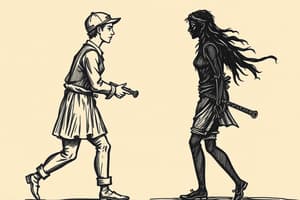Podcast
Questions and Answers
What type of conflict involves a struggle between a character and societal norms or laws?
What type of conflict involves a struggle between a character and societal norms or laws?
- Character vs.Nature
- Character vs.Society (correct)
- Character vs.Technology
- Character vs.Character
Which of the following best describes a dynamic character?
Which of the following best describes a dynamic character?
- A character who is primarily a background figure.
- A character who lacks clear traits or motivations.
- A character who remains unchanged throughout the story.
- A character who exhibits significant growth or change. (correct)
In which literary genre would you find narratives created from the imagination, such as novels or short stories?
In which literary genre would you find narratives created from the imagination, such as novels or short stories?
- Fiction (correct)
- Poetry
- Non-Fiction
- Drama
Which type of point of view uses the pronouns 'I' or 'we' to provide insights from a character's perspective?
Which type of point of view uses the pronouns 'I' or 'we' to provide insights from a character's perspective?
What is the primary role of the antagonist in a story?
What is the primary role of the antagonist in a story?
Which of the following best exemplifies internal conflict in a character?
Which of the following best exemplifies internal conflict in a character?
Which subtype of external conflict involves a character battling against machines or technological systems?
Which subtype of external conflict involves a character battling against machines or technological systems?
Which narrative perspective is considered the least common in literature as it addresses the reader directly?
Which narrative perspective is considered the least common in literature as it addresses the reader directly?
Flashcards are hidden until you start studying
Study Notes
Types of Conflict
-
Internal Conflict
- Character struggles within themselves (e.g., emotions, decisions).
- Example: A character battling self-doubt.
-
External Conflict
- Conflict between a character and an outside force.
- Types of external conflict:
- Character vs. Character: Direct opposition between two characters.
- Character vs. Nature: Struggles against natural forces (e.g., storms, animals).
- Character vs. Society: Conflict with societal norms or laws.
- Character vs. Technology: Struggle against machines or technological systems.
Character Analysis
-
Protagonist
- Main character driving the story.
- Often faces the primary conflict.
-
Antagonist
- Opposes the protagonist.
- Can be a character or a force.
-
Character Traits
- Descriptive adjectives that define a character (e.g., brave, selfish).
- Can be directly stated or inferred from actions.
-
Character Development
- Static characters: Do not change throughout the story.
- Dynamic characters: Experience significant growth or change.
Literary Genre
-
Fiction
- Narrative created from the imagination (e.g., novels, short stories).
- Sub-genres: Fantasy, science fiction, realistic fiction.
-
Non-Fiction
- Factual writing based on real events (e.g., biographies, essays).
-
Poetry
- Expresses ideas and emotions through verse.
- Features elements like rhyme and meter.
-
Drama
- Written to be performed (e.g., plays).
- Includes elements like dialogue and stage directions.
Point Of View
-
First Person
- Narrator is a character in the story (uses "I" or "we").
- Provides personal insights and feelings.
-
Second Person
- Narrator addresses the reader directly (uses "you").
- Less common in literature.
-
Third Person
- Narrator is outside the story.
- Types:
- Third Person Omniscient: Knows all characters’ thoughts and feelings.
- Third Person Limited: Focuses on one character’s perspective and thoughts.
Types of Conflict
- Internal Conflict involves a character grappling with their own emotions or decisions, such as feelings of self-doubt.
- External Conflict arises from opposition between a character and outside forces, categorized into several types:
- Character vs. Character: Direct confrontation between two individuals.
- Character vs. Nature: Struggles against natural elements like storms or wildlife.
- Character vs. Society: Conflicts arising from societal expectations or laws.
- Character vs. Technology: Clashes involving machines or technological advancements.
Character Analysis
- Protagonist is the central character who propels the story forward and faces the main conflict.
- Antagonist opposes the protagonist; this role can be filled by a character or an abstract force.
- Character Traits are descriptive terms that define a character's personality (e.g., brave, selfish), which can be evident or implied through their actions.
- Character Development can be:
- Static Characters who remain unchanged throughout the narrative.
- Dynamic Characters who undergo significant transformation or growth.
Literary Genre
- Fiction encompasses narratives stemming from imagination, including novels and short stories, with sub-genres such as fantasy, science fiction, and realistic fiction.
- Non-Fiction consists of factual writings based on real-life events, such as biographies and essays.
- Poetry conveys ideas and emotions through structured verse, often featuring rhyme and meter.
- Drama refers to works meant for performance, characterized by dialogue and stage directions, such as plays.
Point Of View
- First Person narrative employs "I" or "we," housing a character's personal insights and feelings.
- Second Person directly addresses the reader with "you," a less frequently used narrative style.
- Third Person perspective comes from an external narrator, divided into:
- Third Person Omniscient: Offers insight into the thoughts and feelings of all characters.
- Third Person Limited: Concentrates on one character's viewpoint and inner thoughts.
Studying That Suits You
Use AI to generate personalized quizzes and flashcards to suit your learning preferences.




